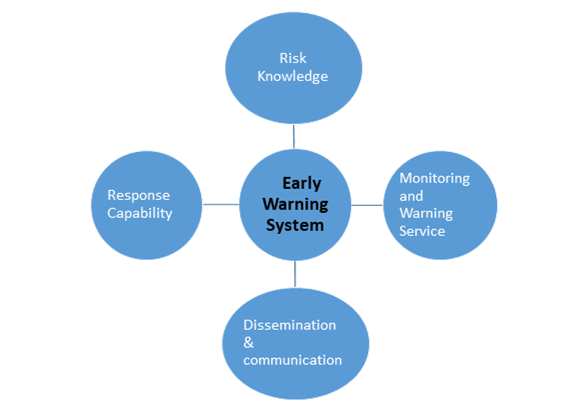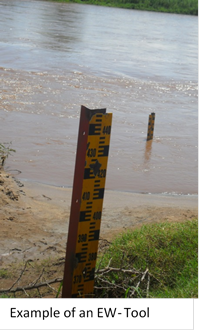Disaster Risk Management (DRM)
Early Warning Systems
Early warning is a major element of disaster risk reduction. It prevents loss of life and reduces the economic and material impact of disasters. To be effective, early warning systems need to actively involve the end users at risk, facilitate public education and awareness of risks, effectively disseminate alerts, and warnings and ensure there is constant state of preparedness. A complete and early warning system has to support a number of functions for it to be effective. This module therefore looks into understanding the concept of early warning systems, their importance, its elements, and benefits and also how to apply the system at across different levels.
Overall Objective - The main objective of this module is to enable participants understand, gain knowledge and skills in early warning systems of different hazards affecting communities.
- Discuss and understand key terminologies in early warning systems.
- Know the different types of early warning systems.
- Appreciate the benefits of early warning systems;
- Understand how different EWSs can be effectively used in different hazard situations.
- Enable participants understand and apply community based early warning systems
The facilitator will use a combination of breaking participants into groups for discussions, presentations and questions and answers to engage session participants
A. Meaning of Warning
An indicator or event that shows a hazard is likely to happen. A warning informs communities in advance of a possible danger, problem or other unpleasant situation.
B. Early warning system.
Early Warning System (EWS) is a set of capacities needed to generate and disseminate timely and meaningful warning information to enable individuals, communities and organizations potentially threatened by hazards to prepare and act appropriately and in sufficient time to reduce the possibility of harm or loss of life, and reduce the economic and material impact of disasters.
Early warning systems need to actively involve the communities at risk, facilitate public education and awareness of risks, effectively disseminate alerts and warnings and ensure there is constant state of preparedness in the communities.
C. Elements of early warning systems.
An effective EWS has four key elements. The first element is to do with knowledge. Are the hazards adequately recognized and known? Are the risks associated with these hazards known? Do we know the vulnerabilities of the communities that face these hazards? Secondly, an early warning system needs to have a monitoring and warning service in place. If the hazards are known, then what are the mechanisms that have been put in place to monitor these hazards? If the situation changes and the risks increase, is there an effective warning service? How will those at risk come to know about the impending hazard in a timely manner?
There may be excellent assessments conducted such that we may know a whole range of hazards facing a particular community as well as the communities’ vulnerabilities; however, the question of dissemination and communication comes up as the third element of a EWS. Communities at risk need to be aware of any warnings that might be generated by the system. Communities at risk need to be provided with tools for effective decision making. This will happen through dissemination and communication, through which the systems warning service will be explained. For example, take the colors sometimes displayed at the lake, a yellow flag means swim with caution, a red flag means do not swim at all. If these signs are not properly explained to patrons, one will assume the flag is probably a goal post for beach soccer and pay no attention to it.
The fourth element of an early warning system is the response capability of authorities and those at risk. If the other three elements are fully operational while there are no response capabilities, the benefit of the purpose of coming up with the system is defeated. From history, failures typically occur in the communication and preparedness elements pointing to human factor and political will as significant factors in any early warning system. These in turn depend on the durability of institutional arrangements as well as public support and awareness of the benefits of the early warning system. These four elements are interrelated and interconnected as shown in the figure below:
The four elements of an early Warning System (Adapted from Basher, 2006)

Communicating Early Warning
An Early Warning System needs a good communication plan that ensures the key messages reach the right people in good time. For every hazard type, the early warning system uses different communication plan for disseminating information. For floods, volunteers may be deployed to monitor water levels and then use bells, whistles or other loud noises to alert the community.
With drought, conditions deteriorate slowly, but many drought-prone areas have a government or meteorological department early warning system. Also, farmers often have their own traditional ways of fore casting drought, for example, by interpreting insect behavior (i.e. increased food gathering activity by ants - sign of impending drought), wind directions or tree flowering patterns. When these are seen, members of the community must be informed accordingly.
With hazards such as flash floods, the early warning system has to be fast and effective, because the community may have only minutes to respond. Bells, whistles, drums and other loud noises are sometimes commonly used to raise the alarm.
D. Types of early warning systems
The category of the types of EWSs refers to natural and human-induced hazards about which societies are concerned enough to want to be warned. Every society has hazards with which it must cope. Every society has various activities that could be categorized as early warning of a harmful or of a beneficial occurrence. Below are some of what are considered to be types of early warning systems:
- Forecasts – These can for example be forecasts of weather or climate anomalies or of technological risks. They provide decision makers and society a ‘heads up’ with regard to the outcome or of the process or event being forecast. Examples are daily or periodic weather forecasts.
- Trends and projections – This can be for example observed global climate changes or cycles with reference to data obtained and analyzed over many years ago. The trends and its stages can be used to predict certain hazardous scenarios and act as an early warning system. Climatic data can also be extrapolated to make projections on continued potentially hazardous climatic changes.
- “Monitoring” – Monitoring is one of the important parts of an EWS. Technical personnel can be assigned roles in monitoring changes of a potentially hazardous scenario by providing technical information to those whose responsibility it is to warn society or communities, or even government. Monitoring and interpretation of water levels on a river line gauge to prevent floods falls under this type of EWS.
- Scenario development - This yet another way to provide insights into potential hazard frequency, intensity, duration and location at various times in the future. Those who generate scenarios can also help to identify potential drivers of unwanted change. Scenarios can help to uncover hazards that might otherwise have caught decision makers by surprise. The further into the future one projects, the more speculative the scenario becomes.
E. Benefits of Using Early Warning Systems
- Early warning systems help to reduce economic losses and mitigate the number of injuries or human loss of life to a disaster, by providing information that allows individuals and communities to protect their lives and property.
- Early warning information empowers people to take appropriate action before an impending disaster situation occurs. If well integrated with risk assessment studies and communication and action plans, early warning systems lead to substantive benefits.
E. Classification of early warning systems.
In the Malawian context, early warning systems can be classified into two; the indigenous/traditional early warning systems and modern early warning systems. We will now cover each separately below:
1. Indigenous Early Warning Systems
Communities especially in Africa have existed long before the emergence of modern studies in disaster management or risk reduction. As entities, these communities have come across disasters of varying degrees in intensity and frequency. From these disasters, communities have accumulated important knowledge of early warning signs that have been passed from generation to generation. These warning signs about impending disasters are what we refer to here as indigenous early warning systems. They include signs and signals of a flooding river (debris in the water); increase in number of female butterflies (Ntchembele Zandonda/Army worms) and increased food gathering activity by ants (sign of impending drought). No studies have been conducted to ascertain the accuracy of most of the indigenous early warning systems. They should therefore be used with caution.
2. Modern/Scientific Early Warning Systems
 Human knowledge has evolved, and so are the technological approaches used in making life easier for mankind. This advancement means that human interaction with the environment has become ever more complex. This complication means that indigenous early warning systems are no longer viable in advanced societies owing to their underdeveloped nature and limited application. To keep up with the advances in technology, modern early warning systems have been developed. Examples in this regard range from river gauges set up in upstream communities (flood early warning systems) to Tsunami early warning systems to Earthquake early warning systems. It is important that early warning systems are not thought of only as physical instruments. These can also be processes that are undertaken for example the collection of food security data which is analyzed and is the basis for famine early warning.
Human knowledge has evolved, and so are the technological approaches used in making life easier for mankind. This advancement means that human interaction with the environment has become ever more complex. This complication means that indigenous early warning systems are no longer viable in advanced societies owing to their underdeveloped nature and limited application. To keep up with the advances in technology, modern early warning systems have been developed. Examples in this regard range from river gauges set up in upstream communities (flood early warning systems) to Tsunami early warning systems to Earthquake early warning systems. It is important that early warning systems are not thought of only as physical instruments. These can also be processes that are undertaken for example the collection of food security data which is analyzed and is the basis for famine early warning.
Application of Early Warning Systems: - Case of Flood Early Warning
One of the most common hazards in the Malawian context is flooding. Flooding has been more frequent in the past decade due to unregulated use of natural resources and poor cultivation systems. These have been coupled with unregulated human settlement patterns. Communities up stream have cultivated carelessly leading to siltation of rivers. Communities along the rivers as well as those downstream have cultivated close to river banks making it easier for rivers to break banks and flood settlements. As can be observed here, downstream communities cannot mitigate the impacts of floods without the involvement of upstream communities. Communities up stream have been used as early warning agents. Using river gauges, they have monitored river levels and provided warnings to downstream communities through the use of cell phones. As we can already see, an early warning system is a system made up of interdependent parts. It relies on the cooperation of these systems to operate in order to work. In the case of the flood early warning system, upstream communities are indispensable even though they are not directly impacted by the floods. Their actions however can save lives.
Recipe for successful early warning: timely, accurate alerts that are specific enough to make sense to people facing a hazard, issued by a credible and reliable source such as an identifiable government agency rather than a plethora of sources, and which are relevant, user-friendly and accessible to all
